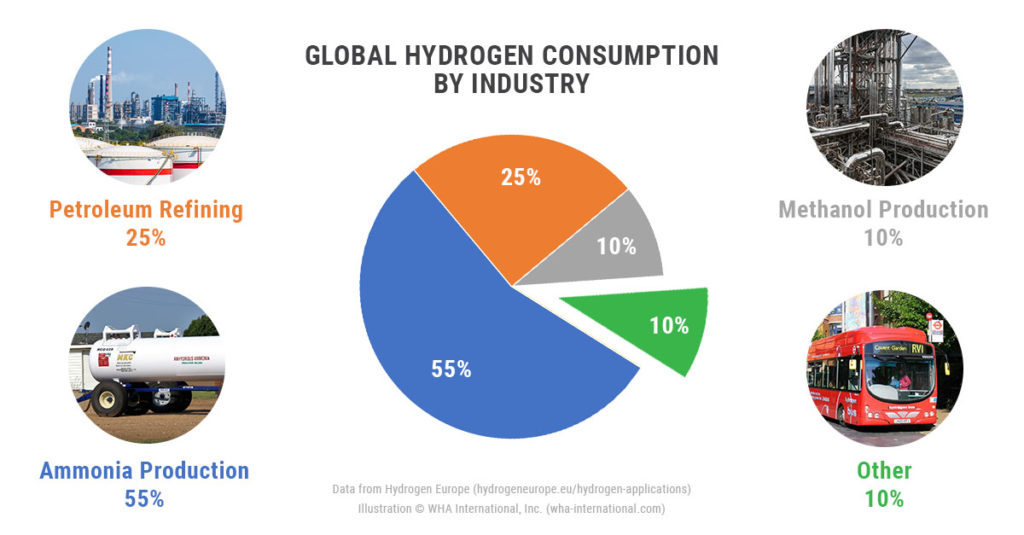FOREWARD
In this article, WHA look at both the historic leaders of global hydrogen consumption and the newer contenders for hydrogen technology and innovation.

Agricultural/Chemical Industry:
Hydrogen is a fundamental raw material needed to produce ammonia (NH3), also known as azane, an important part of fertilizers used in agricultural industries around the world. Ammonia can also be used as an affordable, environmentally-friendly refrigerant (R-717).
Petroleum Refining Industry:
Hydrogen is commonly used in hydrocracking to create petroleum products, including gasoline and diesel. It is also used to remove contaminants like sulphur and to create methanol (CH3OH).
Other Industries:
Hydrogen also is used in several other industries food, metalworking, welding, flat glass production, electronic factory, medical etc.
New Applications:
Newly commercialized applications of hydrogen, like fuel cells, are opening all kinds of new opportunities in transportation and other energy-related industries. In some applications, hydrogen is used as an alternative fuel. Notable growth areas include:
- Space Exploration:
Liquid hydrogen (LH2) fuel has played an important role in space exploration since NASA’s Apollo program, when it was first used in in the secondary stage of the Saturn rockets. Today its use is expanding to include government and commercial organizations like United Launch Alliance, Boeing, and Blue Origin.
- Aviation:
Several experimental programs have utilized hydrogen fuel cells in projects like the Pathfinder and Helios unmanned long duration aircraft. Recently, Airbus unveiled concepts for hydrogen-fueled “ZEROe” aircraft that utilize liquid hydrogen to power modified gas turbine engines.
- Global Logistic:
Dozens of companies with large warehouse and distribution needs are turning to hydrogen fuel cells to power trucks, forklifts, and more. Companies like Tesla Motors, Hyundai, Toyota, Kenworth Truck Co, and UPS have big aspirations for hydrogen powered trucks, vans, and semis.
- Public Transportation:
Hydrogen fuel cells are also being considered for other public transportation applications including trains and buses. Several major cities including Chicago, Vancouver, London, and Beijing have experimented with hydrogen powered buses. Hydrogen-powered trains have now appeared in Germany, and in the next five years, other models are expected to come to Great Britain, France, Italy, Japan, South Korea, and the United States.
- Personal Transportation:
The major auto manufacturers are developing hydrogen fuel cell vehicles (FCVs) designed for personal use.
- Power Generation:
Hydrogen is already used for cooling AC electrical alternator, but it also provides a promising means of electrical grid stabilization. Electrical energy can be turned into hydrogen through electrolysis, then stored and used in an end-use application like transportation.
- Backup Power Generation:
At a local level, stationary fuel cells are used as part of uninterruptible power supply (UPS) systems, where continuous uptime is critical. Both hospitals and data centers are increasingly looking to hydrogen to meet their uninterruptible power supply needs.
